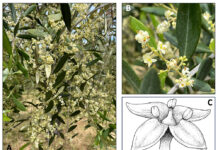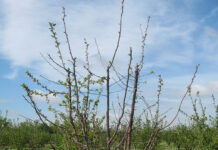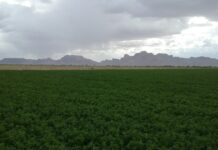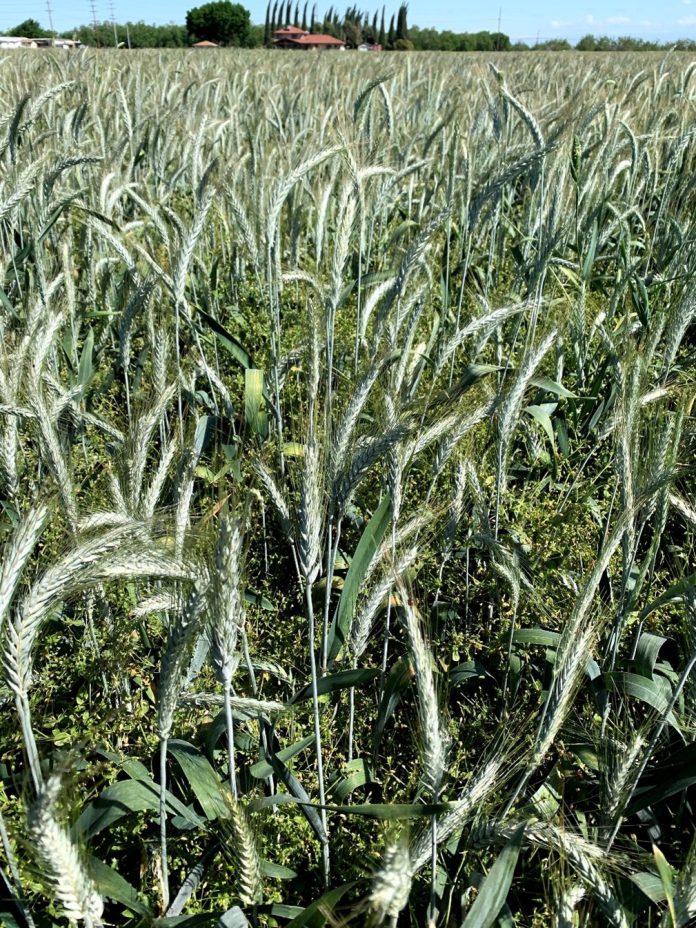
Small grain cereals (wheat, triticale, rye, oats and barley) are planted each year in California on about 550,000 acres from the northern border near Oregon to the southern border near Mexico. These versatile crops can be harvested as grain, straw, hay, green-chop or silage. Today, much of the small grain cereals grown in California are used for dairy cattle feed. Dairy sales topped $7.6 billion in 2021, 14.8% of the state’s crop cash receipts.
Crop yield and quality reduction from weeds is a major concern of small grain producers. From 2015-19, PCAs recommended herbicides on an average of 941,000 small grain acres/year. Many fields were treated more than once for weed control (de Souza Dias et al. 2021). During this period, the most common herbicide modes of action on applied acres were acetolactate synthase (ALS) inhibitors (37.8%), synthetic auxins (31.8%) and protoporphyrinogen oxidase (PPO) inhibitors (17.7%). Major concerning weeds in California small grain crops include littleseed canarygrass (Phalaris minor), Italian ryegrass (Lolium multiflorum), shepherd’s-purse (Capsella bursa-pastoris), London rocket (Sisymbrium irio), mustards (Brassica spp.), little mallow/cheeseweed (Malva parviflora), coast fiddleneck (Amsinckia menziesii var. intermedia), burning nettle (Urtica urens) and common chickweed (Stelleria media).
In 2021, concerns from PCAs in the southern San Joaquin Valley became urgent as they noticed a pattern of failures to control common chickweed (escapes) several years in a row. Some fields were becoming overgrown with the weed (Figure 1).
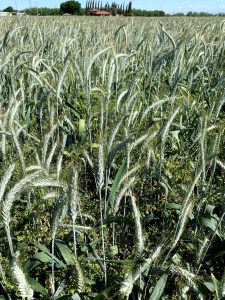
An Emerging Problem
As PCAs and pesticide product representatives noticed some ALS inhibitor herbicides weren’t working as well as expected to control common chickweed in small grains, they conducted field trials and reached out to UCCE Farm Advisors Nick Clark and Jose Dias and Specialist Brand Hanson. In 2021 when it was too difficult to dismiss the repeated escapes as mistakes in applications or poor environmental conditions, several UCCE Farm Advisors gave more attention to fields with escapes and conducted early evaluations attempting to repeat results PCAs and product reps saw in their trials.
The PCAs were concerned they were seeing effects of herbicide resistance. This is a genetic phenomenon occurring naturally as weeds are challenged to live when exposed to herbicides. Genetic variation in the weed population gives some individuals natural resistance to the damaging effects of the herbicide. The problem arises when the same herbicide is used repeatedly, and those naturally resistant individuals continue to reproduce and become dominant in the weed population.
The diligence of these PCAs is the reason the broader ag community alerted early to this potentially serious problem.
Early Warning Grows into Full-Blown Research
Early testing in a field with high common chickweed pressure and documented escapes from ALS inhibitors showed Clark, Dias and Hanson that herbicide resistance could not be ruled out as a potential cause of the escapes. In that field, Clark and Dias applied tribenuron methyl (Dupont Express Herbicide with Totalsol Soluble Granules) and pyroxsulam (Simplicity CA), two frequently used ALS inhibitors in California, at two and four times the highest allowable label rate. Clark and Dias observed that tribenuron slightly reduced the common chickweed growth and pyroxsulam had virtually no effect when compared to an untreated control (Figure 2). This evidence warranted more intensive studies on common chickweed populations with ALS inhibitor escapes. Clark partnered with California State University, Fresno Professor Anil Shrestha to conduct controlled environment trials. These were designed to learn whether these weeds were resistant to ALS inhibitors.
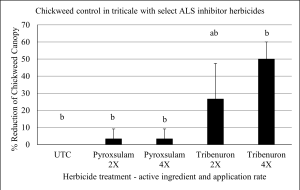
Seeds were collected by Clark and technicians Ben Halleck (UCCE) and Walter Martinez (Tulare County) from common chickweed in ALS inhibitor escape fields and an organic field where there was no recent ALS inhibitor application. The organic seeds were ALS inhibitor susceptible controls because their population was not pressured to evolve resistance. The weed seeds were planted in pots in a greenhouse and grown under a shade structure at Fresno State until they reached the ideal growth stage for ALS inhibitor control. After several experiment repetitions, Clark, Shrestha and Fresno State students Paola Vidales, Kiera Searcy and Jennifer Vidales confirmed what PCAs worried about. The common chickweed identified as ALS inhibitor escapes was in fact genetically resistant to tribenuron methyl and pyroxsulam (Heap 2023).
The UCCE and Fresno State team observed that the ALS inhibitor resistant common chickweed responded to increasing doses of pyroxsulam but not to tribenuron methyl. When the dose of pyroxsulam was increased up to eight times the max label rate, the treated common chickweed became more stunted and more of the plants died. Because the plants were not controlled with the maximum allowable rate, they are considered resistant. When using tribenuron methyl, the common chickweed plants sprayed with eight times the max allowable label rate appeared the same and survived as much as plants sprayed with half the label rate. Many of the plants survived the herbicide applications and eventually flowered, suggesting they may be reproductive.
The UCCE and Fresno State team held public field days at Fresno State. Product reps, PCAs and students gathered to observe the results of the study (Figure 3). The value of the field day was two-fold: 1) ag professionals and students learned about the confirmation of common chickweed populations in California that are genetically resistant to ALS inhibitors, and 2) the research team gleaned important insights from the ag professionals’ feedback. That feedback has been critical in guiding ongoing research.

Future Directions
The two different responses between the herbicides gave clues to the researchers about the ways the plants were expressing resistance to the herbicides. Fresno State professor Katherine Waselkov, specializing in genetics of herbicide resistance, joined the team to begin exploring the genetic basis of this problem in California. The major question Waselkov is researching is whether the Central Valley populations of chickweed showing resistance to ALS inhibitors have mutations in the ALS gene, which codes for the enzyme targeted by the herbicides. By extracting DNA, conducting PCR and sequencing the entire ALS gene, the lab can detect possible resistance mutations that occur in this enzyme. Changes in several amino acids that directly interact with the herbicides are likely to cause resistance. These changes have been detected in other countries’ chickweed infestations (Marshall et al. 2010; Laforest and Soufiane 2018). Waselkov’s different approach will also screen for other less common mutations that could cause resistance.
Pyroxsulam and tribenuron methyl are not the only ALS inhibitor herbicides used in small grains. Industry professionals pointed out mesosulfuron-methyl (Osprey Herbicide), although used less commonly, is also regularly applied to small grains. Additionally, it was pointed out that small grain fields where common chickweed was resistant to ALS inhibitors were recently rotated out of or into alfalfa, a common rotation partner, where multiple ALS inhibitor herbicides are applied to control several important weeds. For these reasons, the UCCE and Fresno State team continues to expand the controlled environment study to determine the presence of ALS inhibitor resistance in common chickweed with more herbicide products.
Fresno State Masters student Jennifer Valdez-Herrera is earning a degree in plant science through further study into ALS inhibitor resistance in common chickweed in California. Studying under Shrestha, Waselkov and Clark, Valdez-Herrera is addressing all the issues above in addition to studying the impact that uncontrolled common chickweed has on yield and quality of small grains.
Growers and PCAs are apt to point out ALS inhibitors are a very important tool for controlling multiple serious weeds in small grains and alfalfa. Further, there are still several other herbicide modes of action registered for California small grains and alfalfa which have activity against common chickweed. The PCAs are the first line of defense in the field and the first consultants for knowledge about how to remedy weed problems. Our team continues to consult PCAs to guide future research endeavors in this field to make sure the solutions we seek are relevant and applicable to the industry.
References
Dias, J. L. C. dS., Clark, N., Mathesius, K., Light, S., Hanson, B., Lundy, M. E., Shrestha, A., 2021. Poor control of common chickweed with ALS-inhibitor herbicides reported in multiple small grain fields in the southern San Joaquin Valley. Is it a new case of herbicide resistance in California? UC Weed Science Blog. Retrieved 7/28/23, https://ucanr.edu/blogs/blogcore/postdetail.cfm?postnum=50181.
Heap, I., 2023. The International Herbicide-Resistant Weed Database. Retrieved 7/28/23, http://weedscience.org/Pages/Case.aspx?ResistID=24253.
Laforest, M., and B. Soufiane. 2018. Coevolution of two sulfonylurea-resistant common chickweed (Stellaria media) biotypes with different mutations in the acetolactate synthase gene. Weed Science 66: 439-445.
Marshall, R., R. Hull, and S. R. Moss. 2010. Target site resistance to ALS inhibiting herbicides in Papaver rhoeas and Stellaria media biotypes from the UK. Weed Research 50: 621-630.


